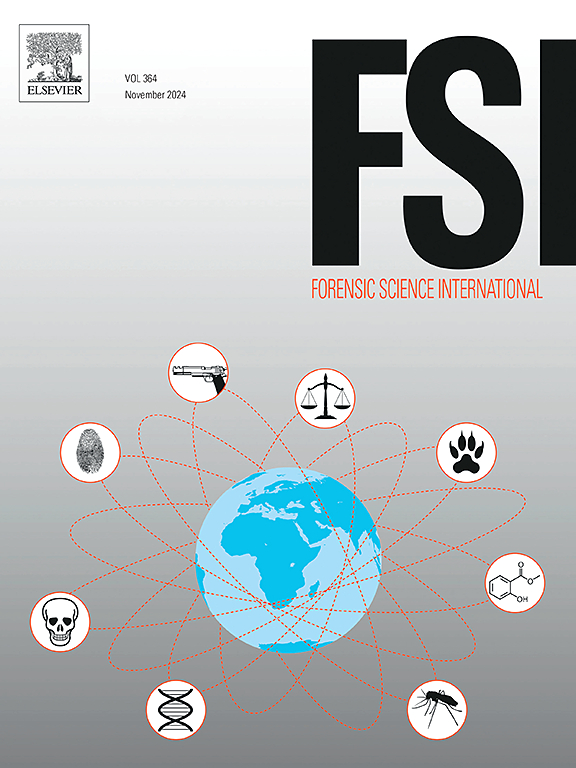Integrating temporal dynamics of both microbial taxonomic and functional characteristics as a tool for forensic time since deposition estimation
IF 2.2
3区 医学
Q1 MEDICINE, LEGAL
引用次数: 0
Abstract
Predicting the time since deposition (TsD) of body fluid stain at a crime scene is highly valuable in forensic investigation, as it can connect a DNA-identified stain donor to a crime or estimate the post-mortem interval in forensic case involving cadaver. Previous study has demonstrated the applicability of microbial taxa for TsD prediction. In this proof-of-concept study, we explored the combined use of taxonomic and functional characteristics in human saliva microbiome for TsD prediction. We investigated the potential correlations between the temporal dynamics in microbial communities and the TsD of saliva stains, utilizing the relative abundance of microbial genera, amplicon sequence variants (AsVs), and the metabolic function pathway profiles. The results revealed that changes in the metabolic function pathway profiles of microbial communities could contribute to TsD estimation of the aged saliva stains. We developed ensemble models with multiple heterogeneous algorithms, also combined microbial species and metabolic function pathway profiles for TsD estimation. The TsD prediction model, developed using the relative abundance of the top 50 microbial genera and metabolic functional pathway profiles with the xgboost algorithm, achieved high accuracy (R2 = 0.76, mean absolute error = 6.28 days) in a 60-day deposition. Besides, we further interpreted the model and identified potential biomarkers for TsD estimation of saliva stains. The current study provided the first evidence to explore the potential of using multiple data modalities for predicting the TsD of aged saliva stains, offering valuable insight for forensic investigation.
整合微生物分类学和功能特征的时间动态,作为沉积估计以来法医时间的工具
预测犯罪现场体液污渍的沉积时间(TsD)在法医调查中具有重要的价值,因为它可以将dna鉴定的污渍供体与犯罪联系起来,或者在涉及尸体的法医案件中估计死亡时间间隔。已有研究表明微生物类群可用于预测TsD。在这项概念验证研究中,我们探索了将人类唾液微生物组的分类和功能特征结合使用来预测TsD。我们利用微生物属的相对丰度、扩增子序列变异(asv)和代谢功能途径谱,研究了微生物群落的时间动态与唾液污渍TsD之间的潜在相关性。结果表明,微生物群落代谢功能途径谱的变化可能有助于老年唾液污渍的TsD估计。我们建立了具有多种异构算法的集成模型,并结合微生物物种和代谢功能途径来估计TsD。利用xgboost算法建立的前50种微生物属的相对丰度和代谢功能途径谱的TsD预测模型在60天的沉积中获得了很高的准确度(R2 = 0.76,平均绝对误差= 6.28天)。此外,我们进一步解释了该模型,并确定了唾液污渍TsD估计的潜在生物标志物。目前的研究提供了第一个证据来探索使用多种数据模式来预测老年唾液污渍的TsD的潜力,为法医调查提供了有价值的见解。
本文章由计算机程序翻译,如有差异,请以英文原文为准。
求助全文
约1分钟内获得全文
求助全文
来源期刊

Forensic science international
医学-医学:法
CiteScore
5.00
自引率
9.10%
发文量
285
审稿时长
49 days
期刊介绍:
Forensic Science International is the flagship journal in the prestigious Forensic Science International family, publishing the most innovative, cutting-edge, and influential contributions across the forensic sciences. Fields include: forensic pathology and histochemistry, chemistry, biochemistry and toxicology, biology, serology, odontology, psychiatry, anthropology, digital forensics, the physical sciences, firearms, and document examination, as well as investigations of value to public health in its broadest sense, and the important marginal area where science and medicine interact with the law.
The journal publishes:
Case Reports
Commentaries
Letters to the Editor
Original Research Papers (Regular Papers)
Rapid Communications
Review Articles
Technical Notes.
 求助内容:
求助内容: 应助结果提醒方式:
应助结果提醒方式:


